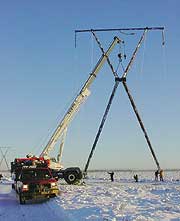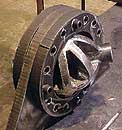 |
| SWINGER Towers used hinge and ball joints. |
Transmission lines often present challenges relating to site conditions, but few can match those encountered in Alaska for construction of a new 97-mile, 230-kv line through parts of Fairbanks, across 60 miles of wetlands and discontinuous pemafrost and up into the mountains to Healy.
Fairbanks-based Golden Valley Electric Associations $100-million line will be finished by Labor Day and includes 18 types of towers to handle varying terrain. Portions can only be reached for three months during the winter and other areas cannot be reached overland at all.
 |
Anticipating future upgrades, Golden Valley built the line to handle 230 kv, but will operate it at 138 kv. The line also has a battery backup system with 18,000 1.4-volt nickel cadmium batteries that will kick in if power from Fairbanks is lost. The batteries will provide 20 Mw of power to the line for 15 minutes, long enough for Golden Valley to bring its powerplants on line. Golden Valley plans to double that next year with another 12,000 batteries.
The multitude of towers was designed by Dryden-LaRue, Anchorage. In urban areas the line is supported by single-shaft, Y towers with cross beams. On the gravelly river valley outside of Fairbanks stand single-shaft towers with standoff insulators, chosen because they take up less space in the right of way.
Beyond the cities, where space is not a problem but access is, work must often be done with helicopters. As a solution, Dryden-LaRue designed guy-supported, X-frame towers that can be assembled lying down, then lifted into place.
Valmont Industries, Omaha, fabricated the X-frame towers from weathering steel. The X-frames have hinge joints at their base that are bolted to 12 to 16-in.-dia pipe foundations with adjustable clamps. In mountainous areas, the towers were built with one leg shorter than the other and they have ball-and-socket joints at the base.
Since the freeze and thaw cycle and permafrost can move and heave foundations, a shear-release loop is built into all guy lines. Foundation movement of up to 1 ft should not affect tower stability, but further movement could. When the tension in the guy wires reaches a critical point, the shear pins break, releasing a loop of extra wire in the guy line.
The weather didnt always cooperate. "Our Bureau of Land Management permit required that [in the wetlands], the ground had to freeze to 12 in. and we had to have 12 in. of snow on the ground before work could begin," says Greg Wyman, Golden Valleys project manager. "But...we had record-low snowfalls and the contractor had to make snow in order to construct the ice roads."
Wyman says the biggest challenge was the use of helicopters in remote areas. "It was more difficult and the cost was higher than anticipated," he notes.
|
